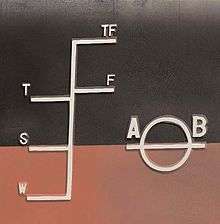American Bureau of Shipping
 | |
| Not for profit | |
| Industry | Marine Classification |
| Genre | Classification Society |
| Founded | 1862 |
| Headquarters | Houston, Texas, U.S. |
Number of locations | 200 offices |
Key people | Christopher J. Wiernicki, Chairman, President & CEO |
| Services | Classification |
Number of employees | 5,500 |
| Website | www.eagle.org |
The American Bureau of Shipping (ABS) is a classification society, with a mission to promote the security of life, property and the natural environment, primarily through the development and verification of standards for the design, construction and operational maintenance of marine-related facilities. At the end of 2012, ABS was the second largest class society with a classed fleet of nearly 12,000 commercial vessels and offshore facilities.[1][2] ABS' core service is the provision of classification services through the development of standards called ABS Rules. These Rules form the basis for assessing the design and construction of new vessels and the integrity of existing vessels and marine structures.[3]
History
ABS was first chartered in the state of New York in 1862, to certify ship captains. It has been involved in the development and improvement of safety standards. Born out of a need for industry self-regulation, ABS published its first technical standards, Rules for Survey and Classing Wooden Vessels, in 1870. When the era of wooden ships gave way to iron, ABS established standards for these structures, published as Rules for Survey and Classing of Iron Vessels. Similarly, when iron gave way to steel, ABS Rules for Building and Classing Steel Vessels were established and published in 1890. These Steel Vessel Rules continue to be revised and published annually.
Organization and management

ABS has been organized as a not-for-profit since its founding in 1862. ABS has been commissioned by the US government and the US Coast Guard to act in many maritime matters and has hired several former officers from the Coast Guard.[4] ABS is required under US law to maintain its status as a not-for-profit organization in order to maintain its role as the agent of the US government on matters of government vessel classification.
The world headquarters as well as the ABS Americas Division headquarters for ABS are located in Houston, Texas, USA. The divisional headquarters for Europe is located in London and the divisional headquarters for Asia Pacific is located in Singapore. ABS has more than 5,500 employees worldwide and is broadly divided into 2 groups: Engineering review and Surveying. ABS Engineers work in office buildings in Houston, Hong Kong, Singapore, London, Shanghai, Busan, Yokohama and other cities. Surveyors are employed in ports and shipyards worldwide to verify that ships are built according to the drawings.[5]
Services
Classification
The responsibility of the classification society is to verify that merchant ships and marine structures presented to it comply with Rules that the society has established for design, construction and periodic survey. Classification itself does not judge the economic viability of a vessel. Neither is the society in a position to judge whether a vessel is ultimately employed according to the stated intended purpose for which it was classed. The classification society records, reports and recommends in accordance with what it has seen at the time of a vessel's construction and subsequent surveys. If a vessel is found not to comply with the Rules, and the recommendations of ABS are not followed, then the society will suspend or cancel classification.
Rules are derived from principles of naval architecture, marine engineering and associated disciplines. A new Rule, or a proposed change to an existing Rule, originates with one of the ABS Consulting technical committees, from in-service experience, from a new IACS Unified Requirement or from the ongoing research conducted by the technology staff at ABS. Research projects are conducted either directly by ABS or are undertaken jointly with industry, with academic and governmental organizations or with other appropriate partners to best draw on the most qualified sources available.
When an owner first requests that a vessel or structure be classed, the shipyard or design agent presents drawings and calculations to ABS for a systematic detailed review for compliance with the Rules. ABS engineers review the plans to verify that the structural and mechanical details conform to the Rule requirements.
After a design has been approved by ABS engineers, ABS field surveyors attend the vessel at the shipyard from keel laying to delivery.The surveyors verify that the approved plans are followed and the Rules are adhered to. During the construction of a vessel built to ABS class, surveyors witness, at the place of manufacture or fabrication, the tests of materials for the hull and certain items of machinery as required by the Rules. They also survey the building, installation and testing of the structural and principal mechanical and electrical systems.
When completed, a vessel undergoes sea trials attended by an ABS field surveyor. The vessel is then presented to the ABS Classification Committee which assesses the vessel's compliance with the Rules based on the collective experience of the Committee members and recommendations from the ABS staff. The Classification Committee is composed of ABS Members drawn from the maritime industry, United States Coast Guard and ABS officers. When accepted by the Committee, formal certification is issued to the vessel. The vessel's classification information, characteristics and other particulars are then entered into the ABS Record – the electronic register of vessels classed by ABS maintained and updated on the ABS web site.
ABS Consulting Rules require that every classed vessel be subject to periodic surveys to determine whether it is maintained in accordance with classification standards. Surveys are based on a five-year cycle of Annual Surveys, an Intermediate Survey to be completed between the second and third years of the five-year period, and a comprehensive Special Survey including dry docking at each fifth anniversary from the time of the vessel's delivery.

Certification
ABS also offers certification to specified standards. Whereas classification requires periodic surveys of the classed vessel or offshore unit throughout its life, certification verifies that the item conforms to designated standards at a specified time. Certification can establish compliance with ABS, national, international, industry or other standards.
Offshore & Energy Services
ABS also develops standards for the design, construction and operational maintenance of offshore drilling and production units and for gas carriers of all types. These standards cover mobile offshore drilling units (such as jackup rigs, semisubmersible rigs, and drill ships), floating offshore production installations (spars, tension leg platforms, semisubmersibles and FPSOs/FSOs), fixed offshore installations, pipelines, risers, and single point moorings.
Statutory Services
ABS also acts as a Recognized Organization on behalf of more than 100 governments. A Recognized Organization is authorized by a flag State to conduct plan review and statutory surveys on ships registered under that flag on behalf of the nation's maritime administration. Typical regulations include the U.S. Code of Federal Regulations (CFR), SOLAS, MARPOL regulations, and the Load Line Convention. In addition to the national or international tonnage certificates, Panama and Suez Canal tonnage certificates can be issued by ABS on behalf of those authorities.
Naval Vessel Standards
The ABS Rules for Building and Classing Naval Vessels are developed for naval vessels. The standards address the bulk of hull, mechanical, electrical, environmental and safety related criteria for the vessels.
The Naval Vessel Rules have restricted distribution, unlike the other ABS Rules and Guides which are available for download or hardcopy purchase.
Rapid Response Damage Assessment (RRDA) Program
Decisions made within the first few hours following a maritime casualty can determine the outcome, i.e. whether or not the vessel will remain intact and the potential environmental impact. The RRDA program provides an organized team of engineers and naval architects during emergency situations.
Since 1993, RRDA engineers have contracted HECSALV software to model more than 2,000 vessels including floating production, storage and offloading (FPSO) units, tankers, bulk carriers, gas carriers, semisubmersibles and spars classed by the major classification societies. Teams have responded to more than 180 worldwide incidents ranging from tank explosions, groundings, collisions and fires to minor structural damage, flooding, trimming to replace stern seals, emergency drydockings and structural evaluation with missing structure in repair situations.
The principal role of the RRDA team is to assist the Master and owner's technical personnel. With the ability to quickly calculate the effect of damage to hull structure and free-flooding of internal spaces, we help the owner/operator minimize further stressing of the hull, loss of the vessel due to inadequate stability or spilling harmful fuel and cargo into the environment. The RRDA team can also interface with the vessel's class society and flag or port State officials to provide technical documentation to support proposed temporary repairs, operations, single voyage requests or other related requirements.
Rules & Guides
ABS provide a list of rules and guides to the public.
List of rules:[6]
- Generic Rules for Classification, Materials and Welding and Survey After Construction
- Rules for Building and Classing Steel Vessels (2016)
- Rules for Building and Classing Mobile Offshore Drilling Units (2016)
Prestige Oil Spill
The Prestige was an oil tanker whose sinking in 2002 off the Galician coast caused a large oil spill. The spill polluted thousands of kilometers of coastline and more than one thousand beaches on the Spanish and French coast, as well as causing great damage to the local fishing industry.
For the world maritime industry, a key issue raised by the Prestige incident was whether classification societies can be held responsible for the consequences of incidents of this type. In May 2003, the Kingdom of Spain brought civil suit in the Southern District of New York against the American Bureau of Shipping, that had certified the Prestige as "in class" for its final voyage. The "in class" status states that the vessel is in compliance with all applicable rules of the classification society, not that it is or is not safe.
On 2 January 2007, the docket in that lawsuit (SDNY 03-cv-03573) was dismissed. The presiding judge ruled that ABS is a "person" as defined by the International Convention on Civil Liability for Oil Pollution Damage (CLC) and, as such, is exempt from direct liability for pollution damage. Additionally, the Judge ruled that, since the United States is not a signatory to the International CLC, the US Courts lack the necessary jurisdiction to adjudicate the case. Spain's original damage claim against ABS was some $700 million.
Spain appealed, and the appellate court returned the case to the originating District Court. The resulting New York ruling, released in August 2010, held that there was no existing precedent to assign a duty on behalf of the coastal state.[7]
ABS Academy
ABS Academy, a specialized division of ABS provides marine courses & seminars on classification, regulation, engineering design, new construction, risk management, quality, and environmental awareness to world's leading shipowners and shipbuilders.[8] The programs include:
- Shipbuilders Courses
- Offshore Courses
- Shipowners Courses
- ILO Maritime Labor Convention & Regulatory Update
- Challenges in Arctic Marine & Offshore Operations and more.
See also
- Classification Society
- International Association of Classification Societies
- Prestige oil spill
- Type Approval
References
- ↑ "American Bureau of Shipping Annual Review 2012". American Bureau of Shipping. 2012. p. 10. Retrieved 15 January 2014.
- ↑ ABS Reports Continued Growth in 2012, Strong Foundation for Future
- ↑ ABS Website, What We Do
- ↑ "Tax-Exempt Firm Gets $600 Million Profit Flying First Class". Bloomberg. Retrieved 3 August 2013.
- ↑ ABS Website, ABS Directory
- ↑ itostado. "Rules & Guides". ww2.eagle.org. Retrieved 2016-03-24.
- ↑ Spain Blocked From Suing American Bureau of Shipping
- ↑ ABS Academy Marine Training
External links
- American Bureau of Shipping - ABS corporate Classification website
- ABS Academy - Maritime & Offshore Training
- ABS Nautical Systems - Fleet management software
- ABS Group of Companies - ABS non-Classification services
- ABS Consulting - Risk and marine consulting
- IACS - International Association of Classification Societies